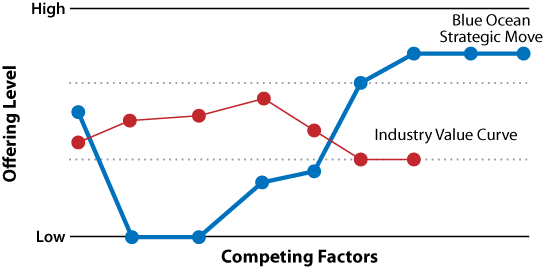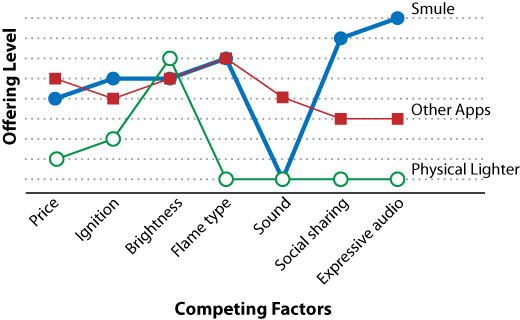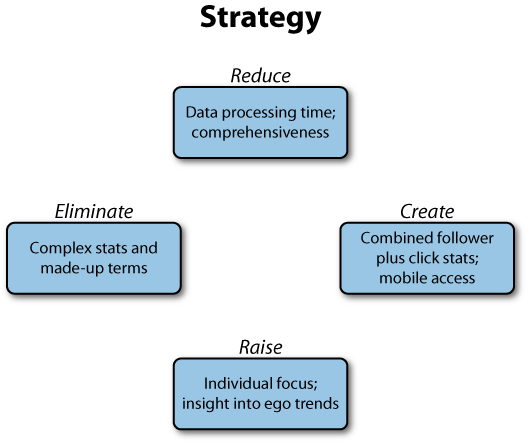You’ve been focused on gathering information about your app landscape and app idea, as well as learning about Apple’s devices and new operating system. Consider these to be some of the raw inputs required to build a fully functional app. Now you need to synthesize these inputs so that you can form an initial set of assumptions about your app.
Creating these assumptions will help communicate how you are trying to make your app a different and compelling offering in the App Store. That is, you’ll have a set of benefits your app proposes to customers compared to other options they have available. Being able to articulate these differences will allow you to incorporate outside perspectives, which will help you validate the assumptions you have about your app.
Being passionate about your app is an important part of launching it into the App Store. I can guarantee you that there are going to be moments where you question what you are doing, you wonder why you are spending nights and weekends in front of a computer while others are relaxing, or you are frustrated that the development of your app is not going according to plan. Above all else, your passion and commitment to your idea will keep you going through these moments. And because you actually quantified your app, you will have some sense of the actual rewards possible, which will motivate you to stick with what you are doing.
More relevant to the current discussion is that being passionate about your idea likely equates to you also being knowledgeable about the market or industry where your app is relevant. You have been further expanding that knowledge and should continue to do so for the life of any app you build, but you probably have some sort of starting point. That’s a huge advantage, because solving a problem or filling a void in a market that you are intimately familiar with is one of the best ways to lead you down a path where you create something useful and compelling. In short, build an app to solve the problems you experience firsthand.
Of course, passion can trip you up by making you think that your way to meet needs and solve problems in the form of your app is the way to do it. Few companies and businesses have the right to think that way—Apple is one of them. For you, proceeding with that perspective alone can cause you to squander a potentially great opportunity in the App Store market.
If you abide by the strategic framework that follows and the customer-driven mindset that I’ll begin outlining more heavily in Chapter 3, you’ll have the proper balance of validated innovation. On the one hand, you’ll be Apple-like in that you will seek to be market-disrupting. On the other hand, you’ll also include customer perspectives to validate the strong set of assumptions you’ve developed about your app before actually building it. This means your customers will have seen your app before it appears on the App Store. This approach marries these two somewhat contrasting schools of thought: promoting bold innovation while reducing the possibility of your assumptions being dramatically wrong.
It would be easy yet wrong for me to simply write that you should make your app “unique.” I don’t think anyone launches an app into the App Store because she thinks it will be boring or uninteresting. So, requesting that you make your app “unique” is simply not helpful.
At the core of uniqueness lies the concept of innovation. To become unique, one must alter or change the essence of what exists—innovate—to bring something new and exciting to the market. As you can imagine, this subject is comprehensive, and entire books have been written about it, some of which, ironically, aren’t particularly innovative. Blue Ocean Strategy: How to Create Uncontested Market Space and Make the Competition Irrelevant by W. Chan Kim and Renée Mauborgne (Harvard Business Press), however, has fundamentally shifted my approach to building products (and not just “apps”) for the past five years. I’m going to highlight some of what has been most relevant to me and offer it as a more strategic approach to discovering the opportunity for your app.
Competitive markets, being innovative, and related subjects have been researched, analyzed, discussed, and written about for decades. Admittedly, people much smarter than I am have thought more extensively about these topics. With that in mind, consider what I’m about to lay out for you to be a sampling of the core aspects of what you need to keep moving forward with your app idea. So, although Blue Ocean Strategy is a great addition to your bookshelf, you don’t need to read all of it before you can proceed with the process of creating your app.
- “Blue oceans”
The core lesson of Blue Ocean Strategy is to move out of the “red ocean” of competition and into the “blue ocean” of uncontested market space. That might seem intuitive, but the reality is that most businesses—and in the context of our subject, app developers—wind up taking on competition directly by only marginally improving the existing features of an app. The result is twofold:
Developers wind up fighting over the same customers.
Price becomes a primary means for customers to distinguish among apps.
The second point is part of what caused the so-called “race to the bottom” in App Store prices. That is, in a competitive App Store, when there is little to differentiate an app, developers turn to lowering price as a means to win customers. A price war can ensue until prices can go no lower than the $0.99 minimum. The outcome is good for customers but bad for developers.
- Moving to uncontested markets
Of course, the solution to not getting caught in that cycle is to not enter it. The Blue Ocean Strategy authors emphasize that “the only way to beat the competition is to stop trying to beat the competition.” To do that, your mindset needs to change from focusing on existing demand to demand generation, from customers to noncustomers, and from competitors to alternatives. Ultimately, you are not looking to win existing markets, but to make competitors irrelevant by moving into uncontested market space in the App Store.
- Value innovation
Moving your app into a blue ocean starts with the concept of value innovation. Unlike a value proposition, which focuses on benefits for customers only, value innovation considers actions that positively affect both you and your customers.
You can generate value innovation by raising features customers like, creating ones they’ve never seen, and reducing or eliminating ones that don’t really matter to them. Reducing or eliminating features is what will benefit you, because this will lower the cost of bringing your app to the App Store. That may mean, for example, that pricing your app lower than competitors’ actually won’t impact your bottom line. Unlike them, you will operate at a lower cost structure, saving time by not developing expensive but inconsequential features.
- Strategy canvas
Part of the reason I asked you to begin familiarizing yourself with the apps in your market in Chapter 1 is so that you can construct your strategy canvas. A strategy canvas is a visualization that does two things:
It maps out the features currently offered by competitors’ apps.
It will soon help you identify the areas to innovate.
Think about a strategy canvas as being a simple graph, with features (competing factors) for existing apps listed horizontally and the amount of investment in each feature by a competitor rated on the vertical axis from low to high (offering level). By rating the investment into each feature for each comparable app in your app landscape, you’ll be mapping out the value curve. The value curve is a representation of how an app performs across the key features of the app landscape. See Figure 2-5.
Figure 2-5. Blue Ocean Strategy canvas: value curves for industry versus blue ocean (source: http://blueoceanstrategy.com/abo/strategy_canvas.html)
- Alternatives and noncustomers
Remember that your goal is to move from a competitive to an uncontested market. In its current form, the value curve you constructed on your strategy canvas focuses only on the features relevant to the current app landscape. It may not be instinctual, but to create a blue ocean, you’ll need to shift focus, “from competitors to alternatives, and from customers to noncustomers...in order to gain insight into how to redefine the problem [your app] focuses on and thereby reconstruct [customer] value elements.”
The Blue Ocean Strategy authors spend considerable time building the case for this idea and defining “alternatives” and “noncustomers.” To more quickly communicate this idea, it’s easiest to understand this unconventional concept through an illustration. I’ll point to the extremely successful application developer Smule. Smule has produced such apps as Magic Piano and I Am T-Pain (see an interview with Smule co-founder and CEO, Jeff Smith, at the end of this chapter).
One example of why Smule exhibited blue ocean strategies is that its first app was the 19th virtual lighter on the App Store, yet it quickly rose to the #1 position on most App Stores around the world. Unlike developers of existing lighters, Smule recognized that lighters in and of themselves catered to only a small population of customers. Smule’s innovations included creating a social and musical component, which it calls “expressive audio.” Its Sonic Lighter iPhone app had the ability to “ignite” other flames on iPhones around the world, which could be seen within the app on its now-famous globe view. The flames could also be controlled via the built-in microphone of the device (know those device features!).
Smule’s leveraging of the social aspects found in other alternative apps, typically games, and creating this “expressive audio” helped the company move away from focusing solely on the existing competing features of similar apps. Instead of just developing a more visually appealing lighter, it redefined the value elements of why people wanted an app like a lighter. By doing so, it significantly broadened the appeal of the app to noncustomers, which is a large part of what pushed the app quickly up the App Store charts.
One last note on “alternatives”: while you are developing an app, it can be helpful to think about your app landscape, including alternatives available, outside the App Store. This could include websites, desktop software, or even nondigital solutions.
- The Four Actions Framework
Analyzing alternatives and noncustomers will allow you to add new competing factors on the bottom of your strategy canvas. For example, Smule’s strategy canvas (see Figure 2-6) could have started with items such as price, ignition, brightness, flame type, and sound. As part of its expanded understanding of the market, it could have included social sharing and expressive audio.
The goal in adding these factors of competition is that you will be defining a new value curve—but this one will be for your app. For that to occur, you will leverage the Four Actions Framework, which includes four key questions (edited to be app-focused):
Which features taken for granted in the app landscape should be eliminated?
Which features should be reduced well below other features in the app landscape standard?
Which features should be raised well above other features in the app landscape standard?
Which features should be created that the app landscape has never offered?
If you recall, your value innovation benefits both you and your customers. The main value for you is to lower your cost structure in two ways:
By not building features that are assumed to be useful or important but actually aren’t
By not building features where existing apps appear to be highly competitive
In the second case, the Blue Ocean Strategy authors note that trying to win on those factors will “overserve customers, increasing...cost structure for no gain.”
The first two questions of the Four Actions Framework deal with the situations in the paragraph immediately preceding this one. The second two already surfaced in what Smule uncovered: that is, how to raise customer value and create new demand. Combining the answers to these questions, you will be able to plot a new value curve for your app by considering how to eliminate and reduce certain features, raising others, and creating new features from your assessment of alternatives. The result should be identification of an uncontested market space through a distinct value curve.
If you are having trouble grasping the ideas in Blue Ocean Strategy, let me describe it more succinctly.
You are forming a set of assumptions about what’s important to your customers by analyzing the app landscape. The initial competing factors for your strategy canvas represent the features in the existing apps and other solutions that help solve your customers’ problems today. Assessing complementary or alternative solutions and thinking about noncustomers will broaden your perspective. You’ll then be able to develop a set of ideas (i.e., the assumptions about your app) that will not only better serve customers, but also transition you to the “blue ocean” of uncontested markets.
Some of these concepts may have formalized the way you thought about your app landscape and how to make your app unique. Being dogmatic about using these tools is less important than applying this lens to your app. For example, even if you don’t create a strategy canvas, be sure you understand the competing factors for your app landscape and recognize that focusing on existing customers and competitors alone will keep you swimming in the “red oceans” of the highly competitive App Store.
Understanding the factors of competition for your app landscape and the value curve for your app is a crucial aspect of defining the assumptions about your app. However, you should not get lost in the formality of the framework. Just because you are thinking about your app in a structured manner doesn’t mean you should forget the very human aspects of the app development process.
You previously saw how touch transformed Apple devices and how this and the social element of Smule’s Sonic Lighter were game-changing additions. You need to recognize that your customers are people. Beyond offering the right set of features to them, you need to realize that they like to have fun and to laugh, they are engaged by content, they are enticed by attractive visualizations, and they like it when things are easy to use and work properly. I will address some of these points as I guide you through the process of building your app. For now, I want you to remember two things:
Your customers are emotional beings called humans.
Even the right set of features or assumptions alone won’t make your app successful; you’ll also need to properly execute (i.e., design and develop) them.
The second element is discussed more extensively in Chapter 4 and Chapter 5.
Get App Savvy now with the O’Reilly learning platform.
O’Reilly members experience books, live events, courses curated by job role, and more from O’Reilly and nearly 200 top publishers.




